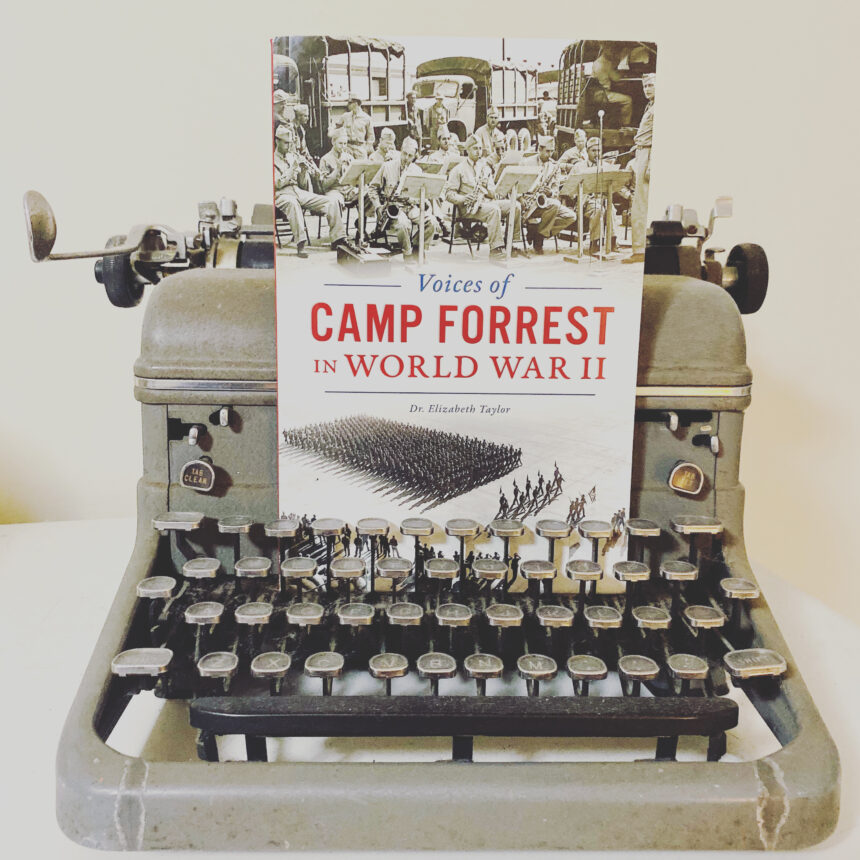
By Tabitha Evans Moore, Editor & Publisher
It once included 1,300 buildings, 55 miles of roads, five miles of railroad tracks, and existed as a self-sustaining city of over 70,000 soldiers and another 12,000 civilians. Today, only a few overgrown concrete foundations remain. Originally built in 1926 near Tullahoma as a National Guard Camp, Camp Forrest served as a crucial induction and training site during World War II.
This is the subject of Dr. Elizabeth Taylor’s newest book, Voices of Camp Forrest in World War II (The History Press, $23.99). She interviewed many who lived, worked, trained and grew up there in addition to newspaper articles from the time, and personal diaries to tell the story. The Lynchburg Times recently caught up with the author to discuss her book with deep southern, middle Tennessee roots.
“I am not from Tenneesee but my interest in Camp Forrest evolved after researching the POWs who were housed there in WWII,” Dr. Taylor said.
It’s a little known fact that Camp Forrest served as a prisoner of war facility during WWII, which held prisoners of German, Japanese, and Italian descent. Prisoners worked on local farms, hospitals, and within the community. It was the first civilian internment camp in the nation at the time.
Voices of Camp Forrest in World War II covers topics such as the impact of Pearl Harbor on civilians and military personnel in the Middle Tennessee area, the construction of Camp Forrest, living and working at and around a city sized military installation as well as the effects of housing German prisoners of war throughout the area and the decommissioning of the base after the war.

In its heyday, Camp Forrest covered nearly 85,000 acres on land that now serves as the footprint of Arnold Engineering Development Complex (AEDC). It housed service clubs, guest houses, a library, post exchanges, a post office, hospital, chapel, a movie theater, and barracks. Major General George Patton once brought his famed 2nd Armored Division from Fort Benning, to practice maneuvers at Camp Forrest. It’s estimated that its mere existence increased the size of Tullahoma by as much as 40 percent.
One of the interesting aspects of the book is the way it explores the many ways Camp Forrest is still with us today.
“Camp Forrest is still very much with us today,” says Dr. Taylor. “When the base was decommissioned, everything was auctioned off … from buildings and autos to cooking supplies and lighting fixtures. Many individuals have told me stories how their family members obtained lumber from the Camp Forrest buildings and used it to build homes and barns. Many of the chapels on base were purchased by local congregations and are still in use today. Much of the 55 miles of roads of Camp Forrest still exist on the old base grounds, but many of the foundations and chimneys are slowly weathering away.”
Dr. Taylor says Tullahoma served as the perfect topographical spot for constructing a military base at that time because the terrain so closely mirrored the European front. It was also helpful that it already hosted a military installation, Camp Peay, the predecessor to Camp Forrest.
But as much positive impact as Camp Forrest brought there were downsides too. Much of the land on which it was built was confiscated by the federal government, leaving many rural farmers displaced. Families who’d farmed the same piece of land for generations suddenly found themselves homeless with little or no compensation.
Then there were the war games.
“The war games simulated the all of the conditions (sights, sounds, and smells) soldiers would face overseas,” said Dr. Taylor. “Tanks did not simply roll down the highways, but rather went through fields and pastures as necessary. It did not matter if a fence was in the way; it become a casualty of the war. In addition to property damage, often times farm animals were affected. For example, hens stopped laying eggs due to the simulated war occurring around them.”
The book mentions many familiar names. It features photos of historic downtown Tullahoma as it existed then and mentions specifically businesses like Clayton’s Shoes and Couch’s Photography, which still exist today. Dr. Taylor also interviewed former Lynchburg resident, Johnny Majors for the book.
“While he did not remember the broadcast about Pearl Harbor, as he was only six years old, Johnny Majors learned about the D-Day invasion listening to the radio with his grandmother, Bessie Bobo,” the book states.
It also talks about Shirley Majors, who worked as a barber in Lynchburg and Tullahoma at the time, playing sports and officiated sporting event at Camp Forrest in his spare time.
After D-Day in June 1944, training drastically reduced at Camp Forrest. After the war was over, the U.S. government declared Camp Forrest surplus property and close it. After the close, instead of returning ownership of land back to local farmers, the site was selected for a new Air Force Base. In 1951, President Truman renamed the area Arnold Engineering Development Center after Air Force General Henry H. “Hap” Arnold.
Voices of Camp Forrest in World War II is available locally at Couch’s in historic downtown Tullahoma as well as online retailers. For more information about Camp Forrest, check out the Camp Forrest website that Dr. Taylor maintains. •
{The Lynchburg Times is an independently owned and operated newspaper that publishes new stories every morning. Covering Metro Moore County government, Jack Daniel’s Distillery, Nearest Green Distillery, Tims Ford State Park, Motlow State Community College, Moore County High School, Moore County Middle School, Lynchburg Elementary, Raider Sports, plus regional and state news.}

